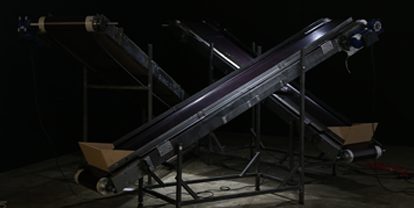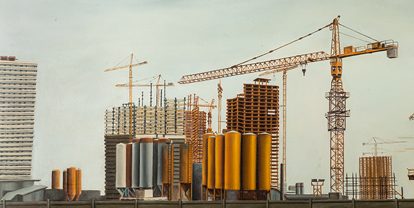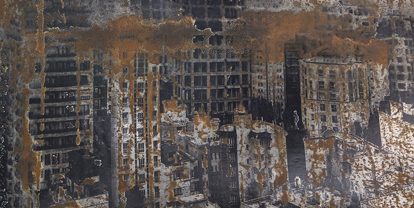A Three-Man Show by Emad Anooshirvani, Azadeh Barbad and Omid Mehdizadeh
Group Exhibition
August 09 — August 21, 2019
Emad Anooshirvani, Azadeh Barbad, and Omid Mehdizadeh exhibit three separate projects with different approaches in a three-man show. Each project addresses notions such as urban density and urban excess as well as eternal recurrence. This city is no longer recognizable in terms of certain notions and concepts; it is rather defined by its innumerable intertwined bridges, multitudes of unfinished buildings, hideous edifices with dingy facades, repetitions, and resumptions.
Typically, Emad Anooshirvani’s installations are dynamic cycles that are static and repetitious at the same time. “Funeral for One, Two, or Three Possibly Dead Bodies” is a machine that is caught in a vicious cycle, showing photographs of different funeral ceremonies indefinitely. This triangular structure represents an ephemeral concept through a permanent object that is inevitably mundane.
In the painting/volume scenario of “Habitat,” Azadeh Barbad represent the two near/far-tangible/intangible statues of the city. Reminiscent of an urban project, this series has been shaped and constructed with different media in a process, which is still in progress. The formal change in the human habitat, which is the result of urban development and its contextual alteration, happens in an unstable process that ebbs and flows through time. In the language of construction, brick, concrete, and urban development, time is an “impermanent” variable. The paintings of “Habitat” are three cityscapes with mature colors, but their painted buildings and structures are caught in a cycle of repetition and crudeness. Having studies sculpting, Barbad specifically emphasizes the significance of from and structure in her paintings and the importance of infrastructure in her volumes.
In the coarse yet detailed volumes and etchings of his “Hideousness” series, Omid Mehdizadeh parodies the vanity of massive urban construction in which personal interest seriously undermines proper groundwork. With its perpetual yet unorganized and dispersed development, urban excess has affected the concepts of time and place. The brutal dominance of looming high-rise, unfinished, and naked buildings are the obvious result of tastelessness and incaution. The etchings of this series depict cityscapes covered with an unfinished, rusty layer that prevents them from glittering. The unstable structures that stand next to the etchings seem to be rotten at the core and about to come apart.


